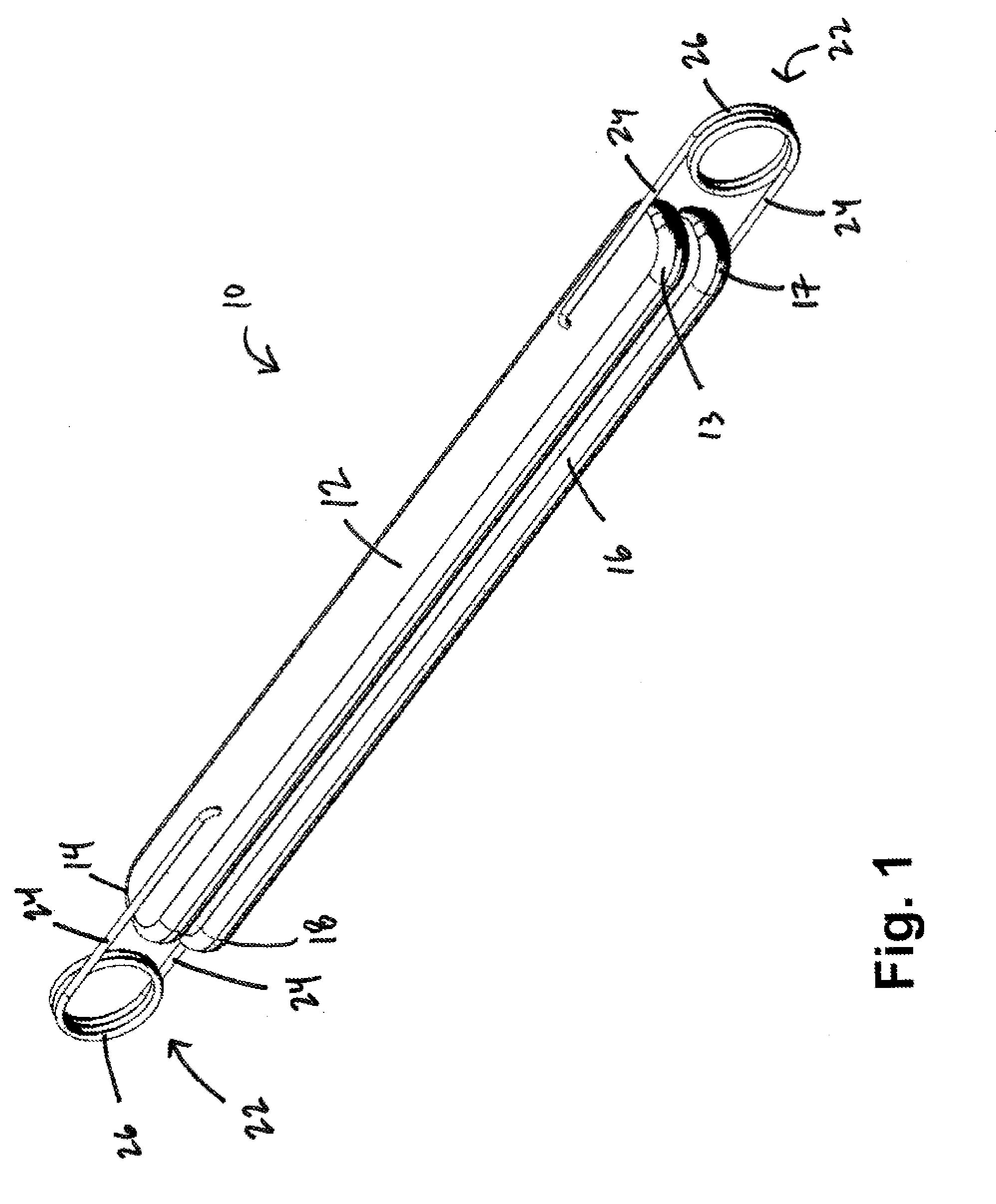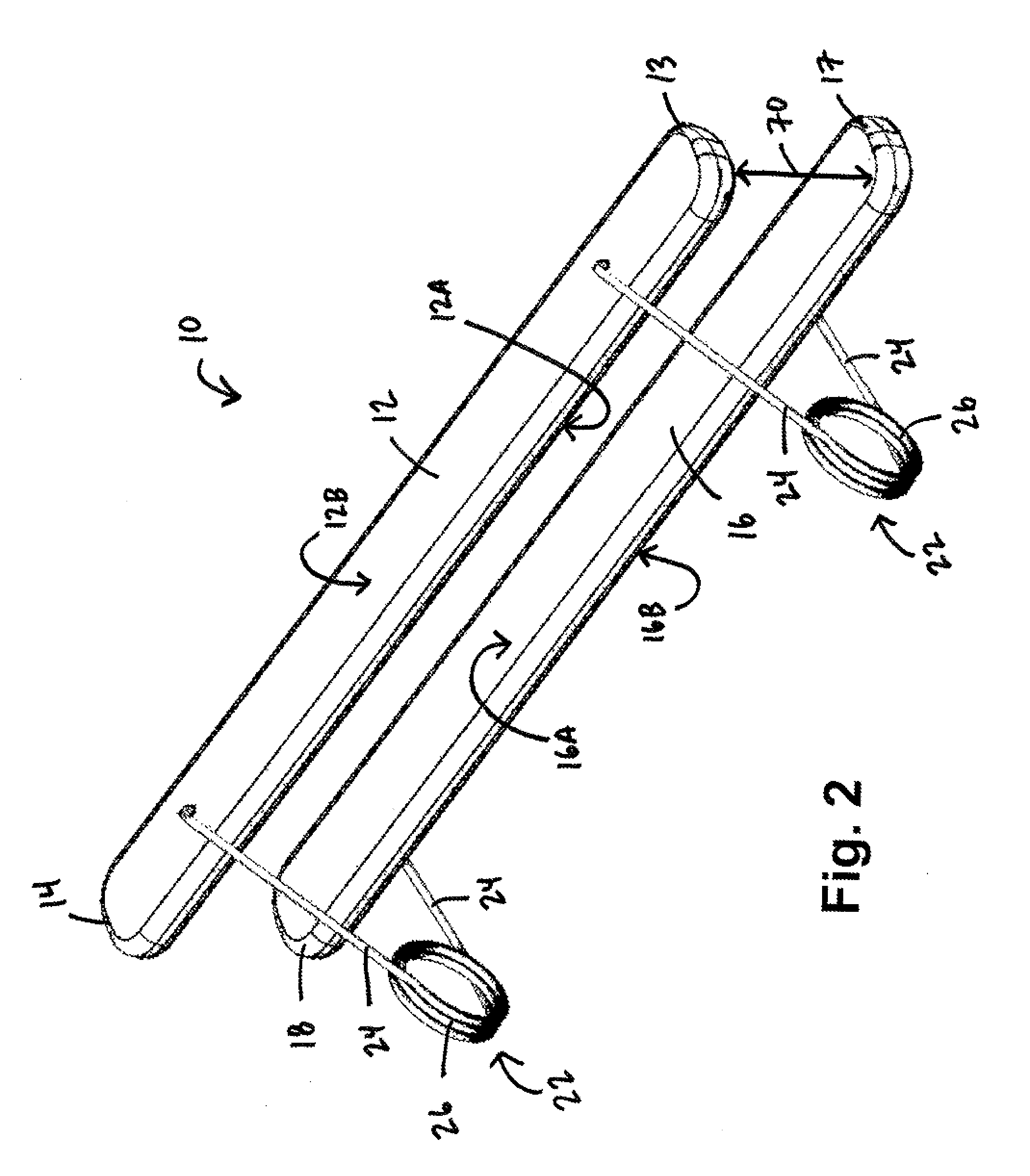[0008]In at least one embodiment of an implantable restraining device of the present disclosure, each of the first engaging component and the second engaging component comprise a configuration chosen from a straight bar configuration, a curved configuration, or a circular configuration. In an additional embodiment, the first engaging component and the second engaging component are flexible or semi-flexible. In yet an additional embodiment, the first engaging component, the second engaging component, and the at least one connector each comprise a material suitable to
resist corrosion, the material chosen from
polyurethane,
polyethylene,
polytetrafluoroethylene, nitinol,
silastic,
titanium, and / or stainless steel. In another embodiment, when a force is applied to the at least one connector, the value of the
interior space is increased.
[0011]In at least one embodiment of an implantable restraining device of the present disclosure, the at least one connector comprises at least one strut, the at least one strut rotatably coupled to the first engaging component and the second engaging component. In another embodiment, the at least one strut comprises at least two struts, and wherein the device further comprises a mesh curtain coupled to at least two of the at least two struts, the mesh curtain operable to limit organ
distension or remodeling when the device is positioned about an organ. In an additional embodiment, the mesh curtain defines at least one mesh aperture, the at least one mesh aperture sized to permit a user to grasp an organ within the at least one mesh aperture to facilitate positioning the device about the organ. In yet an additional embodiment, said device is sized and shaped so that a demi shaft may engage the device so that the device may be positioned within a
body cavity, and removal of the demi shaft from the device allows the first engaging component and the second engaging component to separate from one another.
[0012]In at least one embodiment of an implantable restraining device of the present disclosure, the device further comprises a mesh curtain coupled to the first engaging component and the second engaging component, the mesh curtain operable to limit organ
distension or remodeling when the device is positioned about an organ. In another embodiment, the device further comprises pliable junctions within the first engaging component and the second engaging component to divide each component into two separate subcomponents, wherein each of the two separate subcomponents of the first engaging component and the second engaging component are connected to one another by way of a flexible structure.
[0013]In at least one embodiment of an implantable restraining device of the present disclosure, the at least one connector comprises at least two connectors, the at least two connectors each comprising a coupler, said coupler comprising at least two coupler arms connected to a coupler bar. In an additional embodiment, each of the first engaging component and the second engaging component define apertures sized and shaped to fit said coupler arms so that said coupler arms may inserted within said apertures. In yet an additional embodiment, at least one of the at least two coupler arms comprises a coupler protrusion positioned at or near a distal end of said arms, and wherein the first engaging component and the second engaging component comprise at least one stop at the corresponding aperture where said arm comprises a coupler protrusion, the coupler protrusion sized and shaped to
restrict removal of coupler from the first engaging component and the second engaging component upon engagement of said stop. In another embodiment, the at least two coupler arms of each coupler comprise a pivot member positioned therethrough so that the at least two coupler arms may pivot about one another at the pivot member. In yet another embodiment, each of the first engaging component and the second engaging component define apertures sized and shaped to fit said coupler arms so that said coupler arms may inserted within said apertures and so that said coupler arms may move in a lateral direction corresponding to the first engaging component and the second engaging component. In an additional embodiment, one or more protrusions positioned within at least one aperture are capable of facilitating fixation of coupler arms in a desired position.
[0015]In at least one embodiment of an apparatus for delivering a restraining device of the present disclosure, the apparatus comprises a shaft comprising a distal end, the shaft defining a lumen positioned therethrough, at least one arm operably coupled to the shaft at or near the distal end of the shaft, the at least one arm configured to engage a restraining device comprising a first engaging component, a second engaging component, and at least one connector coupled to the first engaging component and the second engaging component, and at least one pull bar having a distal end, the at least one pull par positioned at least partially within the lumen of the shaft. In at least another embodiment, when a string coupled to the at least one connector is engaged by the at least one pull bar at or near the distal end of the at least one pull bar, the at least one pull bar is operable to change the configuration of the at least one connector upon retraction of the at least one pull bar within the lumen of the shaft. In an additional embodiment, the at least one arm comprises a first arm and a second arm, the first arm operable to engage the first engaging component of the restraining device and the second arm operable to engage the second engaging component of the restraining device. In yet an additional embodiment, movement of the first arm and the second arm in a first direction facilitates the separation of the first engaging component from the second engaging component.
[0018]In at least one embodiment of a method for restoring a targeted tissue of the present disclosure, the method comprising the steps of inserting an exemplary implantable restraining device of the present disclosure into a
body cavity, increasing the value of the
interior space between the first engaging component and the second engaging component of the device by positioning the at least one connector in a second configuration, and positioning the first engaging component and the second engaging component of the device over the targeted tissue such that the targeted tissue is positioned within the
interior space, wherein when the targeted tissue expands in a direction between the first engaging component and the second engaging component, the targeted tissue exerts a force upon the first engaging component and the second engaging component. In another embodiment, the targeted tissue is a
stomach, and expansion of the
stomach, with said device positioned thereon, functionally divides the
stomach into a first stomach portion and a second stomach portion. In yet another embodiment, the targeted tissue is a stomach and wherein the first engaging component and the second engaging component comprise one or more suturing elements positioned at or near the distal ends of each said component, the one or more suturing elements capable of receiving a suture therethrough to approximate the distal ends of said components toward one another. In an additional embodiment, said approximation of the distal ends of the first engaging component and the second engaging component toward one another prevents a
fistula so that food entering the stomach enters a first stomach portion and not the stomach fundus. In yet an additional embodiment, the distal ends of the first engaging component and the second engaging component extend beyond the stomach when the device is positioned over the stomach.
 Login to View More
Login to View More  Login to View More
Login to View More 


